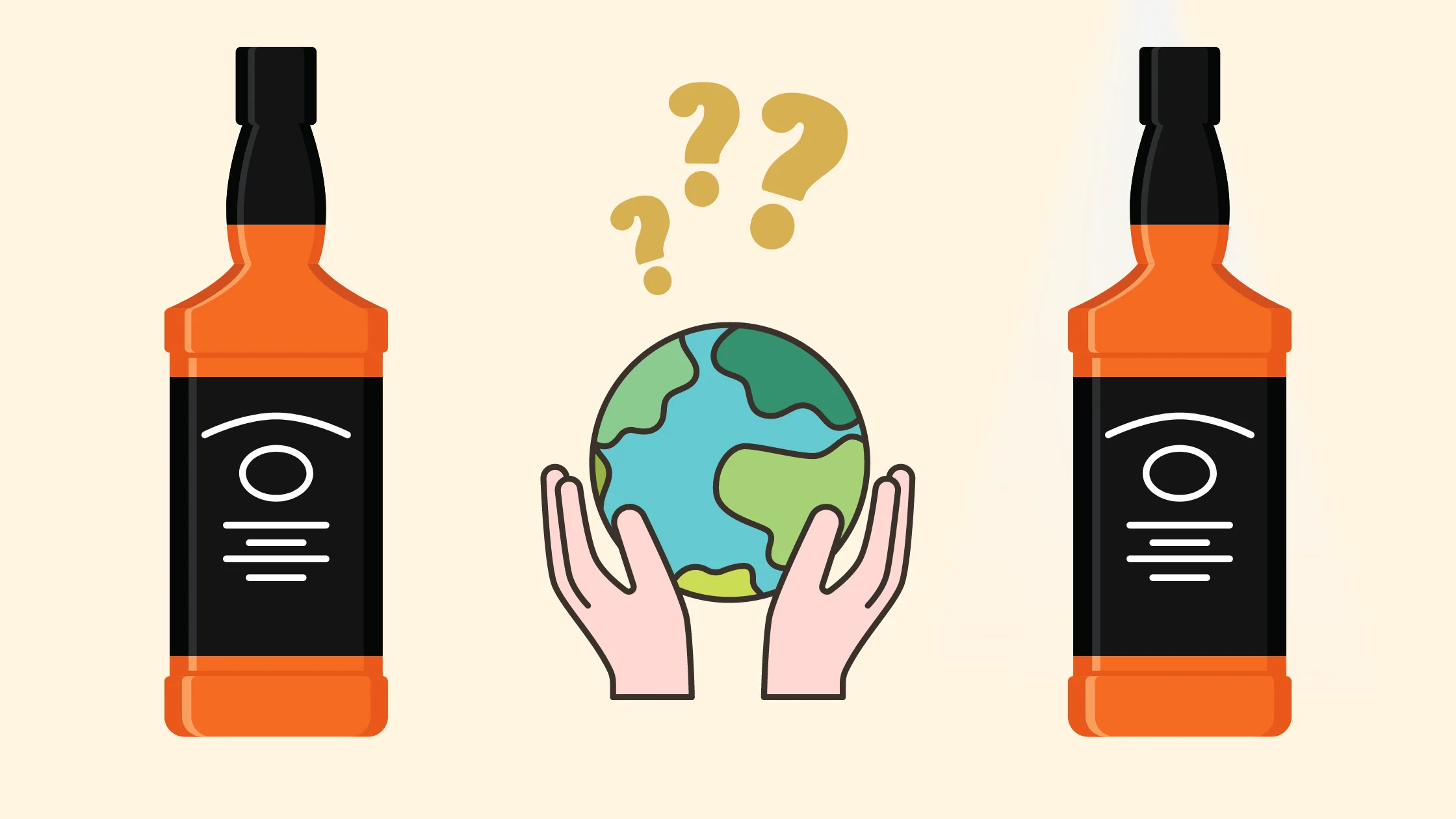Whiskey enthusiasts, have you ever pondered over the environmental footprint of your favorite spirit? The journey from grain to glass isn’t just about aging and taste; it significantly impacts our planet. The whiskey production process is a complex dance involving water, energy, waste, and emissions.
From the vast amounts of water needed for distillation and cooling, to the energy consumed during production, every step leaves an environmental mark. The story doesn’t end with water and energy; waste generation and emissions also play crucial roles. However, it’s not all doom and gloom.
The whiskey industry is stirring towards sustainability, adopting practices like renewable energy and waste repurposing. So, as we savor each sip, let’s dive into the environmental impact of whiskey production and explore how this beloved beverage is navigating the path of sustainability.
What is the environmental impact of whiskey production?
The environmental impact of whiskey production is multifaceted, encompassing water usage, energy consumption, waste generation, and emissions. At the core of whiskey production, vast amounts of water are required, not only for the distillation process but also for cooling and cleaning, leading to potential water scarcity issues in areas where water is not abundant. This process is also energy-intensive, relying on fossil fuels in many instances, thereby contributing to greenhouse gas emissions and global warming.
Furthermore, the production generates various forms of waste, including spent grains and wastewater. While spent grains can be repurposed as animal feed or for generating bioenergy, thereby mitigating some environmental impacts, the treatment and disposal of wastewater remain challenging. This wastewater contains organic materials and chemicals that, if not properly treated, can harm aquatic ecosystems and water quality.
In terms of emissions, distilleries emit volatile organic compounds (VOCs) during fermentation and distillation. These VOCs contribute to air pollution and can have detrimental health effects on local communities. Additionally, the packaging and distribution of whiskey involve the use of glass, cardboard, and plastics, contributing to resource depletion and waste.
However, the industry is increasingly adopting sustainable practices, such as using renewable energy sources, improving water efficiency, and finding innovative uses for waste products. These efforts aim to reduce the environmental footprint of whiskey production, aligning with a growing consumer demand for sustainable and ethically produced goods.
How does whiskey production affect water usage?
Whiskey production significantly impacts water usage through its distillation process, which requires large volumes of water for both the distillation itself and the cooling systems. This extensive use can strain local water resources, especially in areas where water is scarce. Additionally, the production process generates wastewater, which contains organic waste and chemicals.
If not properly treated, this wastewater can pollute water bodies, affecting both aquatic ecosystems and the quality of water available for other uses. The industry’s dependence on water underscores the need for sustainable water management practices to mitigate these impacts, such as recycling process water and implementing advanced treatment processes to reduce pollution.
Distillation Process Requires Significant Water
The distillation process in whiskey production is a major consumer of water, necessitating vast quantities to convert fermented grain mash into distilled spirits.
Cooling Systems in Distillation Use Large Water Volumes
Cooling systems, integral to the distillation process, rely heavily on water to regulate temperatures, further amplifying the industry’s water usage.
Water Pollution from Waste Products
Wastewater generated from whiskey production, rich in organic waste and chemicals, poses a significant risk of water pollution if not properly managed.
Organic Waste and Chemicals Discharged into Water Bodies
The discharge of untreated or inadequately treated wastewater into water bodies introduces organic waste and chemicals, jeopardizing aquatic ecosystems and water quality.
What is the role of energy consumption in whiskey production?
Energy consumption plays a critical role in whiskey production, with the distillation and aging process being particularly energy-intensive. The need for high temperatures during distillation means that vast amounts of energy are consumed, predominantly sourced from non-renewable energy sources like fossil fuels. This reliance not only contributes to the industry’s carbon footprint through CO2 emissions but also highlights the necessity for transitioning towards renewable energy sources to mitigate environmental impacts.
The adoption of solar and biomass energy presents a sustainable path forward, reducing dependence on fossil fuels and aligning with global sustainability goals.
Distillation and Aging Process Energy Requirements
The distillation and aging process in whiskey production demands significant energy, primarily due to the need for controlling temperature and environment over extended periods.
High Temperatures for Distillation Consume Vast Energy
High temperatures required for distillation lead to substantial energy consumption, emphasizing the need for efficient energy use and exploration of alternative energy sources.
Use of Non-Renewable Energy Sources
Whiskey production has traditionally relied on non-renewable energy sources, contributing to its environmental footprint and prompting a shift towards more sustainable practices.
Dependence on Fossil Fuels for Heat and Electricity
The industry’s dependence on fossil fuels for heat and electricity is a major concern, driving efforts to adopt renewable energy sources like solar and biomass to reduce carbon emissions and enhance sustainability.
How does whiskey production contribute to air pollution?
Whiskey production contributes to air pollution primarily through CO2 emissions from fermentation and VOC emissions from the aging process. During fermentation, yeast converts sugars into alcohol, releasing considerable amounts of CO2, a greenhouse gas. Additionally, the evaporation of alcohol during aging, known as the “angel’s share,” emits volatile organic compounds (VOCs) into the atmosphere.
These emissions can contribute to environmental issues like global warming and air quality degradation. Addressing these impacts requires innovative approaches to reduce emissions, such as capturing CO2 for reuse and implementing stricter controls on VOC emissions.
CO2 Emissions from Fermentation
Fermentation in whiskey production is a significant source of CO2 emissions, as yeast transforms sugars into alcohol, releasing carbon dioxide in the process.
Yeast Fermentation Releases Considerable CO2
The action of yeast during fermentation not only produces alcohol but also emits a considerable amount of CO2, contributing to the greenhouse gas effect.
VOC Emissions from Aging Process
The aging process of whiskey releases volatile organic compounds (VOCs), primarily due to the evaporation of alcohol, known as the “angel’s share.”
Evaporation of Alcohol Produces Volatile Organic Compounds
As whiskey ages, the evaporation of alcohol into the atmosphere results in the emission of VOCs, substances that contribute to air pollution and can have adverse environmental effects.
What are the impacts on land and biodiversity?
The impacts of whiskey production on land and biodiversity are significant, stemming from land use for grain production to habitat disruption for distillery construction. Large-scale monoculture farming practices, necessary for growing grains used in whiskey, contribute to soil degradation and loss of biodiversity. Furthermore, the construction of distilleries and associated infrastructure often leads to the clearing of land and alteration of landscapes, which can disrupt local ecosystems and wildlife habitats.
These activities highlight the importance of adopting sustainable sourcing of ingredients and minimizing land use impacts to preserve biodiversity and maintain ecological balance.
Land Use for Grain Production
Grain production for whiskey necessitates extensive land use, impacting soil health and reducing land available for diverse crops.
Large-Scale Monoculture Farming Practices
Monoculture farming, prevalent in whiskey grain cultivation, leads to biodiversity loss and increased vulnerability to pests and diseases.
Habitat Disruption for Distillery Construction
The construction of distilleries requires significant land, often resulting in habitat disruption for wildlife and native plant species.
Clearing of Land and Alteration of Landscapes
Clearing land for whiskey production facilities and related infrastructure alters landscapes, potentially affecting local ecosystems and biodiversity.
How is waste managed in whiskey production?
In whiskey production, waste management involves innovative and sustainable practices to handle solid waste and liquid waste. Spent grains, a byproduct of the distillation process, are often repurposed as animal feed, contributing to a circular economy. Additionally, some distilleries are exploring the use of spent grains for generating bioenergy, further reducing waste.
The treatment of liquid waste, including wastewater, is crucial to prevent environmental pollution. Advanced treatment processes are implemented to clean wastewater before it is discharged, ensuring that organic waste and chemicals are removed, thus protecting water bodies and ecosystems. These practices demonstrate the whiskey industry’s commitment to reducing its environmental footprint through responsible waste management.
Solid Waste from Grain Residues
Grain residues, a byproduct of whiskey production, constitute the primary form of solid waste, necessitating effective management strategies.
Spent Grains Often Repurposed as Animal Feed
Spent grains are frequently repurposed as animal feed, showcasing a sustainable approach to minimizing waste and supporting local agriculture.
Treatment of Liquid Waste
The treatment of liquid waste is critical in whiskey production to prevent the discharge of pollutants into water bodies.
Advanced Treatment Processes to Reduce Pollution
Advanced treatment processes are employed to clean wastewater, significantly reducing pollution and protecting the environment.
What are sustainable practices in whiskey production?
Sustainable practices in whiskey production focus on reducing the environmental impact through water recycling and management, renewable energy sources, sustainable sourcing of ingredients, and waste reduction and recycling initiatives. Water recycling involves reusing process water for cooling and cleaning, minimizing water wastage. The shift towards renewable energy sources like solar and biomass helps in cutting down the reliance on fossil fuels, thereby reducing carbon emissions.
Sustainable sourcing emphasizes organic farming practices for grains, which supports biodiversity and soil health. Waste reduction initiatives aim at implementing zero-waste strategies and circular economy principles, where byproducts like spent grains are repurposed, thus minimizing waste and promoting sustainability within the whiskey industry.
Water Recycling and Management
Water recycling and management strategies are crucial in minimizing water wastage in whiskey production.
Reusing Process Water for Cooling and Cleaning
Reusing process water for cooling and cleaning significantly reduces the demand for fresh water resources.
Renewable Energy Sources
Adopting renewable energy sources is key to reducing the carbon footprint of whiskey production.
Solar and Biomass Energy to Power Operations
Solar and biomass energy are increasingly used to power operations, offering sustainable alternatives to fossil fuels.
Sustainable Sourcing of Ingredients
Sustainable sourcing of ingredients, including grains, emphasizes environmental responsibility and quality.
Organic Farming Practices for Grains
Organic farming practices for grains not only support sustainability but also enhance biodiversity.
Waste Reduction and Recycling Initiatives
Waste reduction and recycling initiatives aim to minimize environmental impact and promote efficiency.
Zero-Waste Strategies and Circular Economy Principles
Implementing zero-waste strategies and circular economy principles ensures that resources are used judiciously and sustainably.





